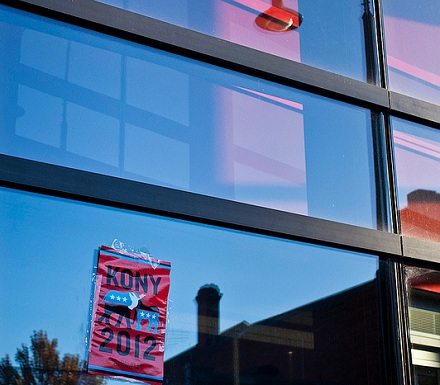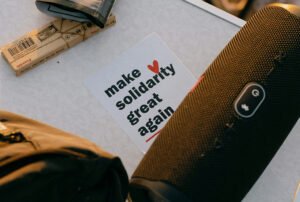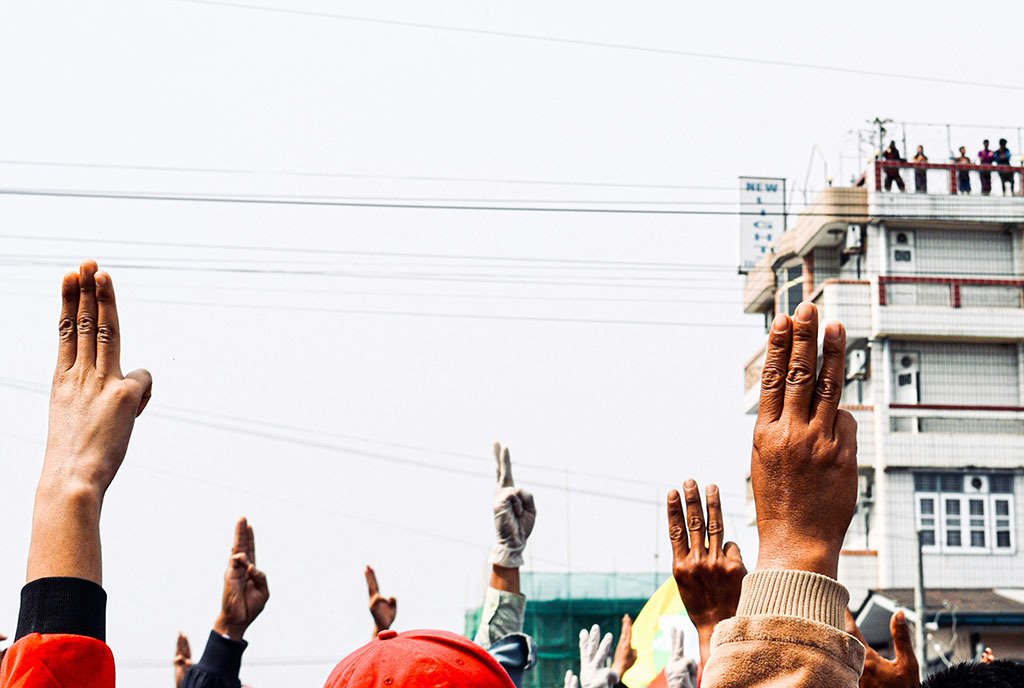
The “Kony 2012” video became YouTube’s most-watched video ever. Upon its release, it drew rapid promises of activism, reportedly from millions of people who pledged to get involved in local activities for Invisible Children’s “make Kony famous” campaign, which was set for April 20, 2012. That date has now come and gone, and the actual turnout—almost everywhere—was lackluster and desultory. Some 3.5 million people had pledged or signed up with Invisible Children to participate in “cover the night” activities, but the planned blanketing of communities with Kony posters, murals, and stickers doesn’t seem to have happened on the massive scale first expected, as the enthusiasm waned after the release of the video on March 8, 2012.
Like many people, if we looked (and we did, both in Washington, D.C. and Boston, Mass.), we could find the occasional poster stapled to a lightpost or some sidewalk chalking, but not much else. Reports from around the world—in the U.K., Canada, Australia, and elsewhere—indicated pretty sparse showings, although there must have been some communities which drew a little more turnout. In Seattle, one report detailed a few dozen teenagers putting up Kony 2012 posters in Pike Place Market only to have a trailing security officer pull them down.
Why did this extraordinary campaign sort of peter out? Something complex happened, and there is likely no one explanation as to why. As such, we offer some commentary within that is not meant to serve as a definitive explanation, but rather to suggest a variety of themes that merit more attention:
Video Killed the Activist Star?
Invisible Children cannot have expected to garner the hits that the Kony video got. Who in the IC shop would have had the temerity to predict 88 million views on YouTube alone, with estimates topping 105 million views overall for the original video? It was a stunning number, but as it focused attention on the advent of viral videos, the video itself became the event. While the video made Kony famous, as IC had wanted, the actions on April 20th were unlikely to make Kony any more famous than he was through the video. In that sense, the video was a huge success, but one which also sucked much of the energy out of the organizing, which may be one reason why online views didn’t translate to action on the street.
Some of the press coverage of the lackluster Kony turnout implied that the results should have been anticipated. This wasn’t the use of social media by Arab Spring protesters or by Occupy Wall Street activists. It was a click-and-send-your-money approach, which much of the press seems to have concluded attracted people who could be active using a mouse on the computer, but not in going to the streets in the model of more traditional mass activism. Many have referred to this phenomenon as “slacktivism” or “clicktivism,” “the modern tendency for people to ‘engage’ in a social action that involves clicking on a web page but then doing nothing more.”
Did Invisible Children fail to capture the names and contact information of the viewers of the videos in a way that allowed them to effectively organize during the period between the video’s release in early March and the turnout event in April? Did they follow up to make sure viewers would do more than click? Was the two months between the video’s release and the day of action too long to wait? Or was it too short for IC to come up with compelling ways of translating 3.5 million online pledges of support into people marching for action against Kony?
Ugandans not on Board
Not long after the release of the original Kony video, a counter-narrative began to emerge. Kony’s heyday, it seems, was long ago, and his Lord’s Resistance Army was now a couple of hundred renegades operating in the corner of Uganda and the Congo, on the run from the Ugandan army. The presence of Kony and his army in that little corner of Africa is a nightmare for the region, but his influence is nothing like it once was. Ugandans reacted quite negatively, both to purported errors of fact and analysis in the IC video and to the implicit portrayal of them as helpless victims unable to deal with Kony unless Americans came to their rescue. Some clearly felt used and abused by Invisible Children, as evidenced by the reactions of Ugandans who found themselves filmed for Kony Part II. For some, it was a matter of, “Why Kony now?” If IC were concerned about horrible conflicts in Africa where communities are terrorized, they could have picked from several of more recent vintage, particularly as Sudan (Khartoum) dispatched Russian-made helicopter gunships to bomb communities along its border with the recently independent South Sudan (Juba) and threatened all-out war.
Where Is the Money Going?
Little plastic or rubber wristbands are now commonplace in many charitable campaigns. Invisible Children offered viewers a $30 Kony 2012 action kit of various materials, posters, and wristbands or a $10 wristband. How much did IC get from the sales of these kits? Until the information is released in IC’s Form 990, there’s no really verifiable number, but Kony 2012 skeptics have charged that IC made tens of millions. For its part, IC says it will not provide information on how much it has raised through Kony 2012 until the summer at the earliest. Still, we can assemble enough information to get some rough sense of how much money IC took in from Kony 2012.
Assume that there were at least 106 million online views of the first Kony video (88 million on YouTube, 18 million on Vimeo), though we suspect that number is conservative as the viral video was shown in a variety of other venues. Fundraising experts might anticipate a one percent response to this kind of pitch, and though we think that is also conservative based on the emotional reaction the video sparked among many people, we can use a lower fundraising response rate of 0.5 percent in order to be absolutely conservative. One half of one percent of Kony video viewers buying $30 action kits is a gross of $15 million. Remember that last year, before the Kony 2012 video, Invisible Children had revenues of nearly $14 million, $10 million of which came from contributions.
Sign up for our free newsletters
Subscribe to NPQ's newsletters to have our top stories delivered directly to your inbox.
By signing up, you agree to our privacy policy and terms of use, and to receive messages from NPQ and our partners.
IC had expected 500,000 viewers of the video, not 200 times that many, and after the video, IC itself claimed 3.5 million people had pledged to join in the cover the night actions, many likely to have donated money or purchased kits. Additional institutional contributions in response to Kony 2012 would have added to the take, including a gift of $2 million from the Oprah Winfrey Foundation. $1 million came in toward helping make the video from JP Morgan Chase, the result of Invisible Children’s winning the Chase Community Giving popularity contest on Facebook. A big supporter of Invisible Children, Humanity United, says that it has provided more than $1 million to the organization.
Despite what appears likely to be an impressive financial haul, there is a sense among some that they are not sure what Invisible Children was doing with the money, or if it was putting it to worthwhile use. As questions emerged about the prospective IC financial haul, doubts built concerning the IC tactics, strategy, and objectives. One Ugandan critic was quoted saying, “We expect the money they are using for making videos and organising for us to watch it, to be given to us for business. We have children to feed and provide them decent shelter. Life is difficult but can the video solve it?” Another, who was in the film, likely because her face was mutilated by the LRA, said, “I became sad when I saw my photo in the video. I knew they were using it to profit.” Those nonprofits that are building schools and training teachers in areas of Uganda where Kony is only a nightmarish memory will probably look to IC for an accounting of how it spent or will spend what is likely to have been a remarkable fundraising haul. That such critics do not know how Invisible Children is spending the money may have been another factor in slowing the group’s momentum.
Satire—or Cynicism—Sets In
Live by the YouTube video, die by it. As criticisms piled up about Invisible Children and its strategy, so did the satires and lampoons. Among the most watched and devastating were parodies shown on Comedy Central’s “South Park” and “The Daily Show with Jon Stewart,” as well as HBO’s “Funny or Die” (which featured “Law and Order SVU” star Christopher Meloni plotting to hunt Kony in a “Dog the Bounty Hunter” outfit). Those were the mainstream parodies, but there were also many other satirical videos on YouTube, the medium in which Kony 2012 caught fire, that may well have received as much attention as the satires on U.S. television, including one that had 4.3 million views that went beyond satire into outright cynicism as to IC’s motives.
Who Are These Guys?
Initially, the reaction to Kony 2012 among some was, “Who are these guys?” This question came up not in reference to Kony or the LRA, but to Invisible Children. They weren’t very well known among activists of all sorts, and were not particularly well known in international NGO circles for the most part. As the skeptical started digging, they discovered some religious evangelism underpinning IC and even charges that IC was hostile to LGBT populations (including reported connections to an anti-LGBT group called “The Family”). This is an important issue in dealing with a country like Uganda, in which evangelicals had been promoting horribly anti-gay legislation (under the direction of Uganda’s less-than-gay-friendly autocrat, Yoweri Museveni). IC did issue a statement on April 9th opposing Uganda’s anti-homosexuality bill. While there may be issues here with IC’s political and religious affiliations and motivations, the critics have to realize that NGOs that operate in conflict areas are often religious NGOs—to their credit. Faith-based NGOs that will dive into areas where few others will go to provide needed services. Nonetheless, Invisible Children’s limited previous visibility within international NGO circles probably didn’t help it much, as there was no coalition to come to its defense when things got rough.
And things did get rough, particularly when, around the mid-point between the release of the video and the scheduled global day of action, IC co-founder Jason Russell had a disturbing and sad public incident involving nudity and other troubling behavior. It would too easy, snarky, tragic, and plain wrong to simply attribute the Kony 2012 event as having flopped because one of the top people at Invisible Children had something of a meltdown on the streets of San Diego and was subsequently hospitalized. But up to that point, the narrator of the Kony 2012 video, Russell, was positioned as something of a hero, counter-posed against the anti-hero Joseph Kony. With the public incident, the heroic narrative cloaking Russell frayed. Russell took on more of the character of a Shakespearean tragic hero—a little like Brutus in Julius Caesar or the titular character from King Lear—perceived by some as well motivated but weakened by a tragic flaw that, in this case, undermined the Invisible Children story. Unlike those in Shakespeare’s day, however, that tragic moment was magnified by the viral video distribution of the Russell incident.
A Runaway Train?
IC must have sensed that something might be going wrong when the Kony 2012 Part II video garnered less than one percent of the viewership of the original, a pretty clear indication of a significant loss of momentum in the campaign. Maybe if IC wasn’t so tied to a video strategy that it became resistant to editing and change, it might have been able to redirect the energies it wanted to channel into April 20th events elsewhere. When it began to appear that April 20th was going to look weak, some redirection might have been in order, but it may it may be that IC had unleashed a movement that couldn’t be re-corralled and IC couldn’t extricate itself from an agenda that needed to be reshaped. Perhaps it was on an inexorable path toward April 20th, whatever it might turn out to be. However, armed with lots of money and high name recognition, Invisible Children might have been able to revise its agenda to do something else.
Measuring the Success and Evaluating the Lessons of “Kony 2012”
If Invisible Children’s measure of success comes down to the number of people putting up posters, IC’s “Make Kony Famous” rallies of last week don’t measure up. The less than fully organized and underfunded Occupy movement spread virally throughout much of the world, accomplished much more with much less, and has changed the narrative not on one man like Kony, but on the entire structure of economic inequities in our society. On the other hand, IC and the Kony 2012 campaign got the endorsements of Hollywood celebrities such as Angelina Jolie and George Clooney and, more importantly, the approval of President Barack Obama.
It also spawned a rare bipartisan initiative in the U.S. Senate, introduced by Sen. Chris Coons (D-Del.), to condemn Kony. How many initiatives, viral or otherwise, garner explicit commentary from the president and move the U.S. Congress into action within less than a two-month period? Perhaps more substantively, within a short time after the launch of the video, the African Union offered 5,000 soldiers, with U.S. logistical support, to join the hunt for Kony.
The story of Kony 2012, like a mix of Shakespearean tragedy and farce, may yet have several scenes, or perhaps an entire act, to go. The San Diego-based nonprofit launched an event that took on a life of its own in which the serious task of taking on a heinous criminal like Kony mixed with the absurdity of South Park parodies and the choice of 4/20—the annual “Weed Day” celebration of marijuana in the U.S.—as the “cover the night” day of action. The implications of Kony 2012, however, are much deeper than whether warlord Joseph Kony and the remnants of his army will finally be captured by Ugandan forces or brought to trial at the International Criminal Court. A major nonprofit sector discussion should be pursued to analyze what the Kony 2012 debacle has to teach about organizing, advocacy, social media messaging, and international aid.













